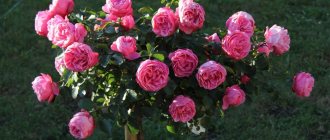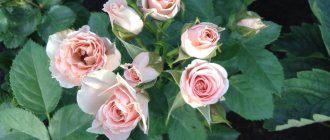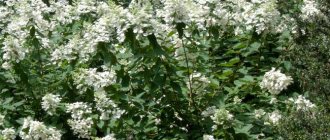Groundcover roses are one of the garden groups of these flowers, most interesting in appearance and quite unpretentious in care. Therefore, if you want to diversify your flowerbed with new varieties of roses, do not be afraid to get this one.
From the moment roses were in the hands of breeders, what varieties of roses can you find today in someone else’s flower garden! And sometimes even in your own. Climbing, standard, scrub, miniature and others-other-others... And, of course, ground cover. We will tell you about them today.
Rating of ground cover roses
When compiling our rating, our team familiarized itself with dozens of varieties of these wonderful plants and the history of their selection. When selecting nominees, the peculiarities of planting and caring for them, reviews from gardeners, and assessments of breeders were taken into account. Particular attention was paid to the following properties:
- The size and number of flowers on the stem;
- The nature of the stem (creeping or drooping);
- Ease of plant care;
- The presence of immunity;
- Frost resistance level;
- Growth rate.
The classification of varieties within a group is based on the difference in the types of shoots, plant height, and width of the area covered. Shoots are long creeping, arched falling, widely branching and short creeping. The bushes grow up to 35 – 250 cm in height. Their working width, depending on the variety, can be up to one and a half meters and from one and a half meters or more.
For ease of understanding the information, we have divided the rating nominees into two groups. The first presents the 7 best varieties of ground cover roses. The second group of five varieties included the most frost-resistant hybrids.
The best soil for plants
Origin and varieties
In the accepted international classification, “ground cover roses” are not classified as a separate group. Modern varieties, along with new varieties that, due to their botanical characteristics, do not fit into other garden groups, are classified as “Modern Shrub Roses”.
Active selection of ground cover roses began in the 70s of the last century. The greatest successes have been achieved by specialists from the nurseries "Kordes" (W. Kordes' Söhne, Germany) and "Meilland" (Meilland International, France) through complex crosses of the Rose Vihura (R. wichura Crepin) with numerous varieties of the crop. The first varieties were distinguished by their small bush height, long whip-like shoots, medium-sized dark green leaves and white flowers. They were characterized by a single flowering. During breeding work, it was possible to develop repeatedly flowering plants with petals of different colors.
Experts call Floribunda La Sevillana (Meilland, France, 1978) one of the first French “ground cover” roses
Today it is believed that the category of ground cover roses is in its infancy. In practice, it includes plants existing in the assortment that maximize their potential as “ground covers”. Some popular cultivars by garden group are presented in the table:
| Garden group | Varieties of ground cover roses |
| Modern Shrub Roses | Ahtiar, Bonica, Cherry Meillandecor, Concerto 94, Cubana, Fair Play, Heidekönigin, Icy Drift, Immensee, Kent, Mirato, Patte de Velours, Rouge Meillandecor, Sea Foam, Snow Ballet, Sommermarchen, White Swany |
| Miniature Climbers (Miniature, Cl.) | Ferdy, Nozomi |
| Polyantha roses (Pol.) / Polyantha & Climbing Polyantha (Pol. & Cl. Pol.) | Lovely Fairy, The Fairy, Yesterday, White Morsdag |
| Floribunda (Fl.) | La Sevillana, Aspirin |
Polyantha rose "Fairy" is often used in decorative landscaping as a ground cover.
Using the classification proposed by the German company W. Kordes' Söhne, groundcover varieties can be divided into 2 subgroups:
- With long shoots spreading horizontally along the surface of the soil, forming flat-growing bushes. Such plants exhibit constant growth of shoots, which in favorable conditions can reach 4-6 meters in length by winter.
- With arched, drooping shoots, creating dome-shaped, spreading, highly branched bushes, the width of which exceeds the height and can reach 3-4 m in diameter. In the West, they are usually called landscape or landscape and are often used to create high curbs when edging roads.
How to choose a ground cover rose
In order not to make a mistake in choosing a rose variety, you need to determine several basic characteristics that will guide buyers. Rose growers are primarily interested in the interior qualities of the variety, i.e. how it will look in the garden. Landscape designers take a somewhat broader view of this. Their task is to eliminate problems in the allocated area, i.e. cover up unsuccessful buildings, fences, and landscape problems with beautiful plants. Let's consider the main criteria.
Growing conditions
Our country is large, there are many climatic zones and they are all different. And almost everywhere there are lovers of growing flowers, including roses. For our gardeners, the most important characteristics will be the frost resistance of the variety, its ability to withstand severe frosts and early spring frosts. Through the efforts of breeders, varieties have been developed that can withstand twenty-degree frosts.
Kordes company specialists were engaged in breeding polyanthus roses for Germany, whose climate is in many ways similar to the weather conditions of our central zone. You can safely choose ground cover roses for the Moscow region from the Cordes collection of hybrids. The most frost-resistant varieties are offered by Canadian breeders. Their collections include varieties of polyanthus roses that can withstand forty-degree frosts.
In addition to resistance to cold, it is very important to know how the rose tolerates prolonged rains. Some varieties begin to rot during this period. This feature is necessarily written down in the characteristics of the variety.
Quality of seedlings
Choose strong seedlings, two to three years old, with smooth, healthy bark. Pay attention to the condition of the roots. They must not be damaged. Be sure to ask what they are offering you, a plant with its own roots or a grafted one, and if grafted, then on what rootstock. Its frost resistance primarily depends on this.
Beginner rose growers should consult an experienced specialist. It is better to buy strong plants from trusted suppliers. An example is the German company Cordes, already mentioned by us. The high quality of its plants is beyond doubt. Dutch, French, and Canadian specialists offer high-quality products.
Fastidiousness in care
The main criteria here are the variety’s resistance to fungal infections: powdery mildew and black spot. These diseases overtake plants in waterlogged soil, rainy climate, i.e. The danger of such an infection arises from dampness. There are no absolutely resistant varieties and there cannot be. Unpretentious roses can also get sick, but much less often than less resistant ones. In addition to diseases, flowers are threatened by pests, for example, spider mites, thrips, etc. Regular and competent treatment of plants is required. This is the only way to keep them healthy and enjoy their beauty.
Popular varieties
We invite you to get acquainted with brief descriptions and photos of ground cover roses, many of which are well suited for growing in domestic gardens and summer cottages, not only in creeping, but also in bush, climbing and standard form.
From the group “Modern Shrub”
Kent (POULcov, Pyrenees, Sparkler, White Cover) – Olesen, Denmark, 1988
The bush is spreading, reaches a height of 60-75 cm and a width of up to 125 cm, and is often used as a ground cover. The flowers are small, 3-4 cm in diameter, semi-double, shining pure white, with a light aroma. Plants continue to bloom luxuriantly until the first frost. The foliage is dark green, neat, and little susceptible to fungal diseases. The variety has won a large number of awards and in many respects is not inferior to the best hybrid tea roses and floribundas.
Used for group compositions on the lawn, in the foreground of borders, often grown in containers
Patte de Velours (MEImater) – Meilland, France, 1999
A bush 60-80 cm high with shoots capable of growing up to 2 meters in length. It is distinguished by abundant flowering and a spectacular two-tone color of flowers: creamy white with red-pink edges. The flowers are medium-sized (5-6 cm in diameter), double (up to 50 petals), collected in inflorescences of 6-15 pieces. The leaves are dark green, matte. A valuable feature of the plant is the absence of thorns. To keep bushes neat without strictly controlling the contour, light annual pruning is sufficient. When planting in massifs, it is recommended to cut out old shoots to the ground once every 3-4 years, and shorten young shoots to a height of about 25 cm from the soil level.
Delicate cream petals are edged with a red edge, which in sunny weather expands and appears more intensely
Sea Foam (Seafoam) – Schwartz, USA, 1963
The bush is strong, with very prickly, drooping shoots, reaching a length of about 1 m (in the southern regions - up to 3 m). It produces buds much later than other roses, in July, but compensates for this with abundant, continuous flowering until late autumn. The flowers are densely double, white or cream, with a pink tint (in the center), which quickly fades and disappears when exposed to sunlight. The foliage is small, dark green, disease resistant.
Domestic gardeners use Sea Foam mainly as a ground cover rose; it is also possible to grow it as a low climber or in the form of a weeping trunk.
Cubana (Korpatetof, Merry Maker) – Kordes, Germany, 2001
The bush is short (about 50 cm), dense, erect, and over time it grows greatly in width and becomes prostrate. The leaves are small, dark green, glossy. The flowers are medium (5-6 cm in diameter), double (17-25 petals), borne in small inflorescences of 3-5 (up to 10) pieces. The buds have copper-apricot petals with a pinkish tint and wavy edges. As it blooms, the color becomes more and more pink, initially having apricot shades, and closer to flowering - cream. The lack of aroma is compensated by abundant, repeating flowering. The plant is characterized by fairly high frost resistance and resistance to fungal diseases.
Charming "Cubana" impresses with the abundance of flowers and their unique coloring
Sommermarchen (KORpinka, Berkshire, Country Touch, Summer Fairytale, Xenia, Country Maid, Pink Sensation, Pink Sunsation) – Kordes, Germany, 1992
One of the most spectacular ground cover roses, presented in some countries under different names. The bush is compact, but spreading, looks great in any garden design in group and single plantings, including container ones. The foliage is dark green and shiny. Flowers appear in clusters of 5-15 pieces, continuously until the first frost. They are given a special brightness by the contrast between the luxurious, lilac-pink petals, scalloped along the edges, and golden stamens. The advantages of the variety include relatively large flowers for a compact bush with a light aroma, abundant and long flowering, and high immunity to fungal diseases.
The variety is very popular all over the world and has been awarded prizes and awards at prestigious international exhibitions.
Dagmar Hastrup ( Frau Dagmar Hastrup, Fru Dagmar Hastrup) – Hastrup, Denmark, 1914
The variety and its varieties (with yellow and red flowers), developed later, are classified as Rugosa Hybrids. The bush is branched, spreading, reaches a height of 60-100 cm and a width of up to 100 cm. The shoots are prickly, densely leafy, and droop beautifully. The leaves are bright green, shiny, wrinkled; in the fall they begin to turn yellow, sometimes turning red, orange or purple. The flowers are simple, cup-shaped, 5-6 cm in diameter, with soft pink petals and a light aroma. Flowering repeats in waves and lasts until the first frost. In late summer and autumn, along with flowers and foliage that changes color, the bush is decorated with ripening red round-shaped fruits. The plant is characterized by very high winter hardiness, endurance in adverse weather conditions and resistance to typical crop diseases.
When growing self-rooted plants, you can obtain many root suckers for vegetative propagation
Miniature Climbers (Miniature, Cl.)
Nozomi ( Heideroslein, Heideroslein- Nozomi) – Toru Ondera, Japan, 1968
The bush is spreading, 50-60 cm high and up to 1.5 m wide, with long shoots covered with lush clusters of small (2-3 cm in diameter) non-double flowers, reminiscent of apple trees, odorless. The petals are pearly pink, narrow, dark pink on the reverse. Flowering is once, but abundant. The foliage is very small, dark, shiny. The variety performs well when grown in hanging containers used for decorating terraces, verandas and balconies; when grafted onto a standard, it forms a luxurious weeping crown; looks good in plantings at the edge of a retaining wall, in mixborders. The plant is very hardy: it can easily withstand heat, has high winter hardiness and moderate resistance to fungal diseases. The only drawback is the need to remove faded inflorescences.
The “creeping” growth form of the bush and zigzag stems make “Nozomi” ideal for decorating gardens in various styles, including “Japanese” rocky ones
Ferdy ( Ferdi, Honamigawa , Honamigawa, KEItoly) – Suzuki, Japan, 1984
The bush is dense, branched, erect, reaches a height of 120-150 cm and a width of up to 150 cm. The shoots are drooping, very prickly. Flowering is once, but very abundant. The flowers are small, 3-4 cm in diameter, semi-double, borne in clusters of 5-10 pieces. The coral-pink color darkens to red as it blooms (especially in hot weather). The leaves are miniature and shiny. The plant is resistant to fungal diseases, but does not tolerate frost, so it requires mandatory shelter for the winter.
The bush grows naturally in the form of a fountain or cascade, requiring virtually no pruning other than light trimming
Polyanthas
Lovely Fairy ( SPEvu) – Spek, Netherlands, 1990
A bright pink sport of the famous variety The Fairy, with the same growth pattern and voluminous clusters of small (3-4 cm in diameter), densely double flowers. A dense, highly branched, spreading bush reaches a height of about 50-60 cm, growing up to 80 cm wide. The foliage is shiny, bright green. Flowering begins later than other roses, in July, but this is compensated by the abundant and continuous appearance of buds that open until frost. The plant is perfect for forming low hedges and covering slopes, and is highly resistant to diseases and precipitation. The decorativeness and hardiness of the variety are confirmed by international awards received in the USA (2000-2001).
Lovely Fairy flowers have a rich, bright pink color and a faint aroma.
White Morsdag (Morsdag Alba, Morsdag Wit, Muttertag Weiss, White Mothersday) – FJ Grootendorst, Netherlands, 1949
The bush is quite compact, low (40-50 cm), growing in width (60-75 cm), with neat, dark green, glossy foliage. The flowers are small (4 cm in diameter), milky white, semi-double, with a weak aroma, collected in large inflorescences; They are distinguished by their original shape: almost regular spherical, which makes them look like unopened peony buds. Flowering is abundant, repeated in waves throughout the season.
The bushes are excellent for planting in the foreground in borders and growing in container culture, but they are most often used in a trailing form.
You can learn about other interesting representatives of the group of polyanthus roses from the article on our website.
Floribunda (Fl.)
La Sevillana (MEIgekanu, Sevillana, Sevillana Meidiland) – Meilland, France, 1978
The bushes are round, densely leafy, grow up to 1.5 m in height and width. Flowering is long, almost continuous, abundant even at the end of the season. Flowers with a weak pleasant aroma, bright scarlet, 7-8 cm in diameter, semi-double, tolerate hot weather well, do not fade in the sun. During rainy periods, a yellow reflection appears on the petals at the base and spot. The leaves are small, bronze-green. To maintain the neatness of the bush, it is recommended to remove fading flowers without waiting for the small red fruits to ripen. The plant is quite resistant to common crop diseases. In the middle zone and in cold regions it grows well only on a powerful frost-resistant rootstock. A universal variety, perfect for lush hedges of constant flowering, isolated and group plantings. Its merits are confirmed by the ADR certificate (1979) and the title “Golden Rose” (1980).
For the bright scarlet color of the flowers, “La Sevillana” is called “flaming”, glowing even on dark cloudy days
Fluorette – Louis Lens, Belgium, 1971
The bush is low, compact, with arched drooping shoots and large, dark green leaves. Grows up to 60-80 cm in height and about 60 cm in width. Recommended for group plantings, in which it can be used as a ground cover. Blooms profusely and continuously throughout the season; semi-double flowers consist of 17-22 petals and reach a diameter of 5-7 cm. The flowers are faintly scented, carmine-pink with a lighter center, and gradually fade to pale pink under the sun's rays.
When fully bloomed, the flowers become flat and show a center with bright yellow stamens
Which ground cover plants are best?
Our team did a great job selecting nominees for the rating. Many ground cover roses have been studied and their characteristics described. Their frost resistance and susceptibility to disease were compared. Customer reviews were analyzed. Thus, only the best plant varieties made it into the TOP. For those who are undecided, we suggest considering a mini rating of the best of the best nominees.
- Purple Rain. German hybrid – that’s what this wonderful hybrid is called and looks like. Many lilac roses cover the creeping branches. It survives frost easily. Disease resistance is average.
- Orfeo. Dutch hybrid. Vigorous specimens perform well in vertical landscape design. Large flowers cover the shoots abundantly, hiding all the imperfections of their support. An excellent option for hedges, decorating gazebos and house walls.
- Rosarium Utersen. Another Climber, tall, with large and lush flowers that bloom periodically. Drapes walls, fences, pergolas and gazebos, creating coziness everywhere and delighting the eye with its beauty.
- Super Excelza. Another German hybrid of excellent quality from the Kordes company. Also a Climber, which works well in vertical compositions. It has proven itself well as a free-standing ground cover bush and as part of horizontal compositions.
The editors of the site hope that our review will help beginning rose growers find their own variety of ground cover rose, decorate their garden, yard, or summer cottage with it, and enjoy the beauty and abundance of these wonderful flowers for a long time.
Features of agricultural technology
According to reviews from gardeners who have experience growing ground cover roses on their plots, caring for them is not particularly difficult. Seedlings of these varieties, like other representatives of the Rosaceae family, develop well in sunny areas, protected from hot and dry or icy gusty winds. Plants prefer light, nutritious, well-drained soils with neutral acidity and deep groundwater.
Most creeping varieties exhibit:
- strong growth during the growing season and the ability to root shoots that “spread” over the soil surface, which creates a dense green covering with flowers of various colors and suppresses the development of weeds;
- unpretentiousness and endurance to adverse weather factors;
- resistance to diseases and pests;
- undemanding with regard to annual pruning;
- ease of propagation by cuttings and layering.
It is recommended to mulch the soil under bushes with arched drooping shoots to reduce moisture evaporation and eliminate the need for regular loosening
The main disadvantage is the lack of winter hardiness of many varieties. But this drawback is largely mitigated with a competent approach to the biological characteristics of plants and careful care. To better prepare for the dormant period at the end of summer - beginning of autumn, it is advisable to fertilize with phosphorus-potassium fertilizers, and in the spring to stimulate growth, add nitrogen fertilizers.
In many regions of our country, gardeners cover bushes for the winter by building a special frame and wrapping it in non-woven materials.
Unfortunately, shoots covered for the winter often freeze, rot, and are affected by fungal infections or rodents, so in October, after the first frost, they are cut back by 20-25 cm, removing unripe parts. The base of the bush is hilled to a height of 10-15 cm. With the onset of stable cold weather, the shoots are tied up, laid on a bed of boards or spruce branches, and a shelter is built on top from scrap materials.
Bonica
This magnificent variety can also be found on sale under the name Meidonomac. An adult Bonika rose turns into a huge spreading bush up to 90 cm high. Pink double flowers, collected in inflorescences, look very delicate and airy. The plant blooms profusely and in several waves. True, the variety also has a minor drawback: the flowers can fade in bright sun. The rose is good in group plantings, suitable for borders, can grow in containers, and also lasts a long time when cut.
| Purpose | Plant height | Bloom | Aroma | Winter hardiness |
| up to 1 m | Repeated, copious | Very weak | Medium, requires cover | |
Subtleties of care
Ground cover roses are low maintenance and easy to grow. They need regular watering, fertilizing, and pruning. Timely prevention and treatment of diseases and protection from pests are also important.
Watering
Roses like moderate watering, but for the first time after planting they are watered once a week. Do this early in the morning to prevent sunburn on the leaves. First, check the condition of the soil. If the top layer has dried out, it means watering is necessary. About 10 liters of water are used per bush. Starting in autumn, the growth of the plant slows down, so it is watered less often.
Fertilizer selection
The plant begins to be fertilized no earlier than two weeks after the leaves appear. The fertilizer is chosen with a multicomponent composition, which includes:
- phosphorus;
- potassium;
- nitrogen.
Next time, fertilizing is done in a month, but always before the first buds bloom. During the period of intensive flowering, fertilizing is not required. In the fall, they are fed a third time with potassium fertilizers.
Trimming
Experienced gardeners do not recommend heavily pruning ground cover roses. When forming a bush, maintain natural dimensions. Branches are pruned in the first year after planting for better tillering. In the future, only broken and dried shoots are cut off. Once every 5-6 years the plant needs to be renewed. To do this, the bush is trimmed, leaving 20 - 30 centimeters at the base.
Pest Control
In order for ground cover roses to delight you with abundant flowering all summer long, they must be protected from damage by insects. Most often, damage to the plant is caused by:
- green aphid;
- leaf roller;
- spider mite;
- slobbering pennies;
- scale insect;
- thrips.
The fight against them begins at the first sign of defeat. The use of insecticidal preparations gives a good and quick effect. Folk remedies also help: a solution of green soap, an infusion of garlic or tobacco.
Disease Prevention
With increased soil and air humidity, the rose is susceptible to fungal diseases. These include:
- powdery mildew;
- black rot;
- rust;
- black spot;
- gray rot.
The affected parts of the plant are removed to stop the spread of the fungus. The sections are treated with an antiseptic. For prevention, bushes are sprayed with antifungal drugs. This is done in the spring, before the rose blooms, and in the fall.
Ground cover roses are suitable for both a small plot and a large garden. Even those who decided to start growing flowers for the first time can grow them. A variety of varieties and decorative functions will help decorate any landscape.
Planting in open ground
Dutch roses - varieties, growing features
Ground cover roses can be planted both in spring and autumn. The exact timing directly depends on the climatic conditions of the region. When choosing the time in the spring, it is worth looking at the threat of frost - it should already have passed by this time. In autumn, you should focus on the time that remains before the onset of frost - during this period the seedling should have time to take root.
The planting location should be chosen taking into account the fact that ground cover roses do not tolerate strong shading, but also suffer from direct sunlight. The best option would be an area that is well lit throughout the day, but at the peak of solar activity, at noon, is slightly shaded. It is in these lighting conditions that the rose will actively increase its vegetative mass and bloom magnificently.
Site preparation and planting technology
Before proceeding directly to planting seedlings in the ground, the site must be prepared. It should be dug up in the fall and rotted manure should be added for digging, and in the spring it should be filled with complex mineral fertilizer. This way the soil will be saturated with nutrients and this supply will be enough for the first few years of seedling growth.
Rules for planting roses require strict adherence
The landing process is carried out step by step as follows:
- The seedling is carefully examined, too long and diseased lashes are cut off, and dry and damaged roots are cut out.
- Prepare a planting hole, the diameter of which should exceed the volume of the root system by 3-4 cm.
- A layer of earthen mixture is poured into the bottom of the recess, which consists of garden soil, manure and mineral fertilizers. If the site was filled with fertilizers in spring and autumn, then the soil can be used without additives.
- The seedling is placed in the planting hole, the roots are carefully straightened and watered.
- Fill the hole to the top with soil and re-water.
- Mulch the surface around the plant with peat.
Attention! If underground waters lie close to the site, a layer of drainage should be poured onto the bottom of the hole. Fine gravel or broken bricks are suitable for this.
Kent
This variety is a real aristocrat. Snow-white flowers, leathery shiny leaves, a dizzying aroma... This rose is a must-have in the garden of connoisseurs of the classic style. The flowers of this short plant are not large, but in inflorescences they look very impressive. The Kent rose blooms profusely and for a long time - until autumn. The plant looks especially good in group plantings and mixborders.
| Purpose | Plant height | Bloom | Aroma | Winter hardiness |
| up to 45 cm | Abundant, long lasting | Strong | Medium, requires cover | |











